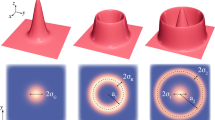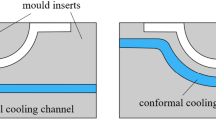Abstract
Co-injection molding and multi-cavity molding are common processes for plastic products manufacturing. These two systems are sometimes combined and applied in the manufacture of bifurcation-structure products. However, how the influential factors truly affect the core penetration behavior and the detailed mechanism of core penetration behavior has not yet been fully understood. In this study, it has focused on studying the multi-cavity co-injection system with a bifurcation runner structure. The results showed that when the skin-to-core ratio is fixed (say 72/28), the melt flow behavior of a co-injection system, utilizing the same material for both skin and core, is very similar to that of a single shot injection molding. Specifically, the non-symmetrical bifurcation runner structure will influence the flow behavior greatly and cause the core distribution imbalance between different cavities. However, it is observed that when the flow rate is increased, the core material will occupy more volume space in the upstream portion of the runner and the core penetration distance will be reduced in the flow direction downstream. This feature is very useful to further manipulate the skin/core interface in a multi-cavity system. Moreover, regarding how to improve a poor inter-cavity balance of core material distribution, using a suitable adjustment of the skin-to-core ratio will be greatly helpful. However, the core break-through defect can be a common problem in co-injection molding when an unsuitable skin-to-core ratio is used. To prevent the core break-through defect, increasing the flow rate properly can be one of the good options that we can use. Hence, it is concluded that a suitable adjustment of the skin-to-core ratio and a proper flow rate control can be used to optimize the core material distribution in multi-cavity co-injection molding with a bifurcation runner structure. Lastly, in order to validate the inference and the effectiveness of this proposal to improve the inter-cavity imbalance and core break-through problem, a series of experimental studies were performed. And, all experimental results are in good agreement with those of our numerical predictions to further validate the feasibility of our proposed method to gain a better control of the core material distribution with a bifurcation runner structure in multi-cavity co-injection molding.
Similar content being viewed by others
References
Foss PH, Tseng H-C, Snawerdt J, Chang Y-J, Yang W-H, Hsu C-H (2014) Prediction of fiber orientation distribution in injection molded parts using Moldex3D simulation. Polym Compos 35(4):671–680
Thomason JL, Vlug MA (1996) Influence of fiber length and concentration on the properties of glass fiber-reinforced polypropylene: Part 1-Tensile and flexural modulus. Composites 27A:477–484
Tseng H-C, Chang R-Y, Hsu C-H (2013) Phenomenological improvements to predictive models of fiber orientation in concentrated suspensions. J Rheol 57:1597
Composites World (2014) Website information: http://www.compositesworld.com/articles/recycled-carbon-fiber-update-closing-the-cfrp-lifecycle-loop, Accessed: Sep. 14, 2015
Job S (2014) Recycling composites commercially. Reinforced Plastics 32–38
Pimenta S, Pinho ST (2011) Recycling carbon fibre reinforced polymers for structural applications: technology review and market outlook. Waste Manag 31:378–392
Garner PJ, Oxley DF (1969) Process for the production of cellular articles. British Patent 1,156,217
Goodship V, Love JC (2002) Multi-material injection molding. Rapra Review Reports 145(13):1–31
Gomes M, Martino D, Pontes AJ, Viana JC (2011) Co-injection molding of immiscible polymers: skin-core structure and adhesion studies. Polymer engineering science 51(12):2398–2407
Messaoud D, Sanchagrin B, Derdouri A (2005) Study on mechanical properties and material distribution of sandwich plaques molded by co-injection. Polym Compos 26(3):265–275
Sun SP, Hsu CC, Huang CT et al (2012) The skin/core material distribution of a co-injection molding process: the effect of processing conditions and material selection, SPE ANTEC Tech Paper, Paper No. 1258422
Liu Q, Ouyang J, Zhou W, Xu X, Zhang L (2015) Numerical simulation of the sequential coinjection molding process based on level set method. Polymer and Engineering Science 55(8):1709–1019
Huang C-T, Yang J, Chang R-Y (2015) Dynamic penetration behavior of core-material in multi-cavity co-injection molding. AIP Conference Proceedings 1695:020002-1-8
Yang WM, Yokoi H (2003) Visual analysis of the flow behavior of core material in a fork portion of plastic sandwich injection moulding. Polym Test 22:37–43
Thomas Technik + Innovation (2016) Website information: http://www.thomas-technik.de/en/bedsystems.htm, Accessed: Aug. 10, 2016
Beaumont JP, Young JH (1997) Mold filling imbalances in geometrically balanced runner systems. Journal of Injection Molding Technology 1(3):133–144
Beaumont JP (2001) Beaumont runner technologies, Inc. “Intra-cavity filling imbalances” Technical Brief
Beaumont JP (2004) Runner and gating design HandBook, (2nd ed, Hanser, Munich), pp 63–110
Chien JC, Huang CT, Yang WH et al (2006) True 3D CAE visualization of intra-cavity filling imbalance in injection. SPE ANTEC Tech. Paper 1153–1157
Chien CC, Peng YH, Yang WL et al (2007) Effects of melt rotation on Warpage phenomena in injection molding. SPE ANTEC Tech. Paper 572–576
Chang RY, Yang WH (2001) Numerical simulation of mold filling in injection molding using a three-dimensional finite volume approach. Int J Numer Meth Fluids 37:125–148
Author information
Authors and Affiliations
Corresponding author
Rights and permissions
About this article
Cite this article
Huang, CT. Numerical visualization and optimization on the core penetration in multi-cavity co-injection molding with a bifurcation runner structure. Int J Adv Manuf Technol 92, 2545–2557 (2017). https://doi.org/10.1007/s00170-017-0330-1
Received:
Accepted:
Published:
Issue Date:
DOI: https://doi.org/10.1007/s00170-017-0330-1




